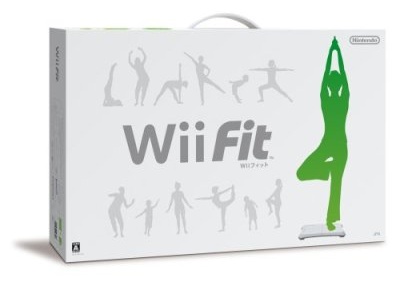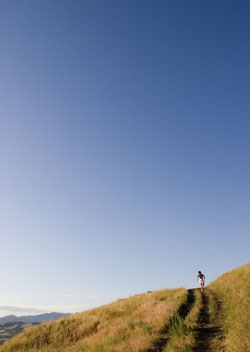I was recently speaking with one of my friends the other day who said, “My New Year’s resolution this year is the same as last, to lose weight.” Of course I laughed out loud at my friend’s obvious irony. I told him what he needed was a more concrete, realistic goal. If weight loss was the only thing he wanted to achieve, then set a goal in pounds, but then I began to think, “Is weight loss really what he is looking for?” I think too many of us set weight loss goals in pounds lost and ignore all of the other positive attributes we gain from being in better shape. Whether it be walking up a couple of flights of stairs without losing our breath or looking better in our clothes, weight loss doesn’t have to be all about the weight. So I decided instead of a weight loss resolution my friend should just make a “Resolve to Run.” I then quickly created a group on facebook at http://www.facebook.com/group.php?gid=105275530330#/group.php?gid=105275530330&ref=mf to see if others would get behind my cause. Feel free to join this movement!
I consider myself a serious runner, but that doesn’t mean I don’t have to constantly set goals to challenge myself in running. In order to get behind my own movement I have decided to set a goal this year to qualify for the Boston marathon. This past year I ran a marathon in which I finished 14 minutes over the qualifying time for Boston. So I would say this is a lofty but very achievable goal for me. Wish me luck and I’ll keep you posted on my progress on this blog.
So why get behind Resolve to Run instead of simply to run instead of lose weight? I’ve found that there is no better way to lose weight and burn calories than to run. I’m not a doctor, but I am a dude who went from 185 to 155 pounds about two years ago and have kept it off! It is simple. No matter what television commercials say or what you tell yourself, the bottom line is: The only way to get the most effective use of your workout is to “beat the street” (or trail). You WILL burn calories. Along with the weight loss benefits you will become more fit overall. You’ll even become more mentally fit, running is the best stress reliever I’ve ever found. Running just makes you feel good. Don’t you want to feel good?
If you Resolve to Run you will stick with it for the whole year. The main reason is because you are able to give yourself positive feedback along the way. Every time you finish a run you feel a sense of accomplishment. Set your goal to run a certain amount every week and then challenge yourself to improve upon that. You will improve. Another great way to get a sense of accomplishment is to make that race you’ve always wanted to run your goal. Honestly, I’ve accomplished many things in my life that I can be very proud of (like being a contestant on the “Price is Right” Bob Barker era), but finishing a marathon ranks in my top five accomplishments for sure. Shoot, I even have it on my resume under interests! Maybe your Resolve to Run will land you a new job. Hey, anything helps in an economy like this one. Did I mention running is free?
So this New Years make a goal you can keep, Resolve to Run. You’ll lose weight, feel healthier, and maybe even accomplish something you can hang your hat on for years to come. So get out there and just RESOLVE TO RUN!

 For years there have been vacations and tours centered around the interests of various recreational groups: guided cycling tours of the French countryside, wine tasting weekends in Napa valley complete with grape stomping, and even fantasy basketball camps for aging dribblers. Sadly it seems like the runners have been largely ignored – or have we?
For years there have been vacations and tours centered around the interests of various recreational groups: guided cycling tours of the French countryside, wine tasting weekends in Napa valley complete with grape stomping, and even fantasy basketball camps for aging dribblers. Sadly it seems like the runners have been largely ignored – or have we? According to the latest numbers available (to us, for free, anyway) running and jogging participation in the US grew steadily from 1998-2004 (Sporting Goods Manufacturers Association). During the six-year period running participation (that is, people who reported running or jogging at least once during the year) increased from almost 35 million Americans to more than 37 million. The biggest jump actually occurred from 2003 to 2004 when more than 1 million new American runners came on board.
According to the latest numbers available (to us, for free, anyway) running and jogging participation in the US grew steadily from 1998-2004 (Sporting Goods Manufacturers Association). During the six-year period running participation (that is, people who reported running or jogging at least once during the year) increased from almost 35 million Americans to more than 37 million. The biggest jump actually occurred from 2003 to 2004 when more than 1 million new American runners came on board.
 The hare can leaves various marks showing the path of the hare, a trail split, dead ends, and short cuts. The front runners usually yell out “On-On” for the rest of the hounds when they see a hash mark indicating they’re on the right trail. A trail split, or “check”, really makes the run interesting, as there may be two or three different directions the trail may go and part of the fun is finding the hare’s correct path. The mischievous hare can make an adventurous run by leading you through urban or wooded areas, muddy
The hare can leaves various marks showing the path of the hare, a trail split, dead ends, and short cuts. The front runners usually yell out “On-On” for the rest of the hounds when they see a hash mark indicating they’re on the right trail. A trail split, or “check”, really makes the run interesting, as there may be two or three different directions the trail may go and part of the fun is finding the hare’s correct path. The mischievous hare can make an adventurous run by leading you through urban or wooded areas, muddy 
 If you’re like me you get tired of running the same route day after day. Heck, running interesting routes is the reason I skip the track and the treadmill whenever I can but sometimes it can be difficult to find new places to run. This is especially true if you generally start and end your runs in the same place most days (like your home or office). Here are some ideas for spicing up your home-base running routes:
If you’re like me you get tired of running the same route day after day. Heck, running interesting routes is the reason I skip the track and the treadmill whenever I can but sometimes it can be difficult to find new places to run. This is especially true if you generally start and end your runs in the same place most days (like your home or office). Here are some ideas for spicing up your home-base running routes: